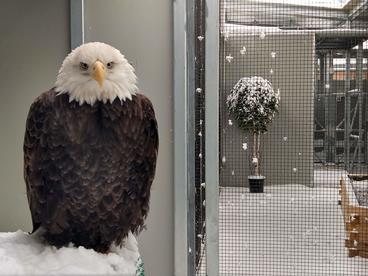As most of us are bundling up or hunkering down to wait out this latest cold snap, our wild raptors don't have that luxury. Bald eagles are a common site in Minnesota during the winter, so how are they dealing with the recent Arctic blast?
A lot of their cold-weather success comes from their amazing feathers. They have thousands of feathers of different types working in harmony to protect from the cold temperatures, harsh winds, and snow and ice.
Closest to their body they have soft and fluffy down. There’s a reason why even with all the synthetic options on the market, many still use down feathers for coats. It works! Of course, we’re not using bald eagle down in our jackets (that would be highly illegal) but instead down from geese or ducks. But the down of bald eagles works the same way – it traps air to be warmed by the body and insulates from the cold.
Bald eagles also have what are called contour feathers. These are what we see on their body and which gives the bird its overall shape. These feathers have a shaft for structure and strength and overlap similar to the shingles of a roof, each on top of the other so only the edges are exposed. The exposed ends of these contour feathers are waterproof and repel rain and snow. Bald eagles fastidiously align, clean, and condition their feathers through preening. Preening is more than making sure you look pretty – it ensures all feathers are in perfect condition to stay warm and healthy. Additionally, an oil from a special gland above the base of the tail is carefully applied by the eagle to each feather to maintain feather integrity and waterproofing.

Bald eagles maximize their feathers’ abilities by fluffing themselves up, trapping lots of insulating air. They also cover their bare feet and toes to keep these featherless areas protected, further warming feet by standing on one leg and alternating which foot gets tucked closest to the body. Bald eagles are able to not just survive our harsh winters, but thrive!
With their incredible adaptations we can still release rehabilitated bald eagles this time of year. This past Friday, us humans bundled up tight to release bald eagle #20-711 back to the wild.
Raptor Center friends Katherine Forrester Schneewind and Randy Schneewind were there to help us get this eagle back to the wild. Originally found on the ground in September, this eagle suffered from internal trauma, abrasions to the feet, and a broken left shoulder bone. Once rehabilitated and recovered from her injuries, the Schneewinds released this eagle at Colvill Park in Redwing, Minnesota along the river where the water is still open and where eagles gather to fish and scavenge. It was a perfect winter day (at least for an eagle) and this now rehabilitated eagle flew away beautifully, given a second chance back in the wild.